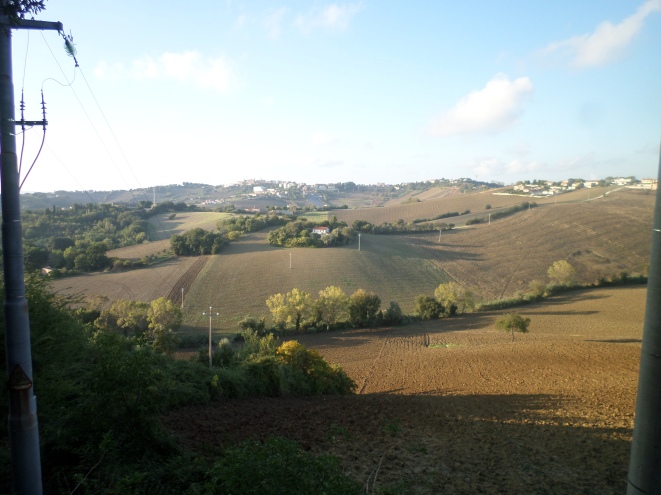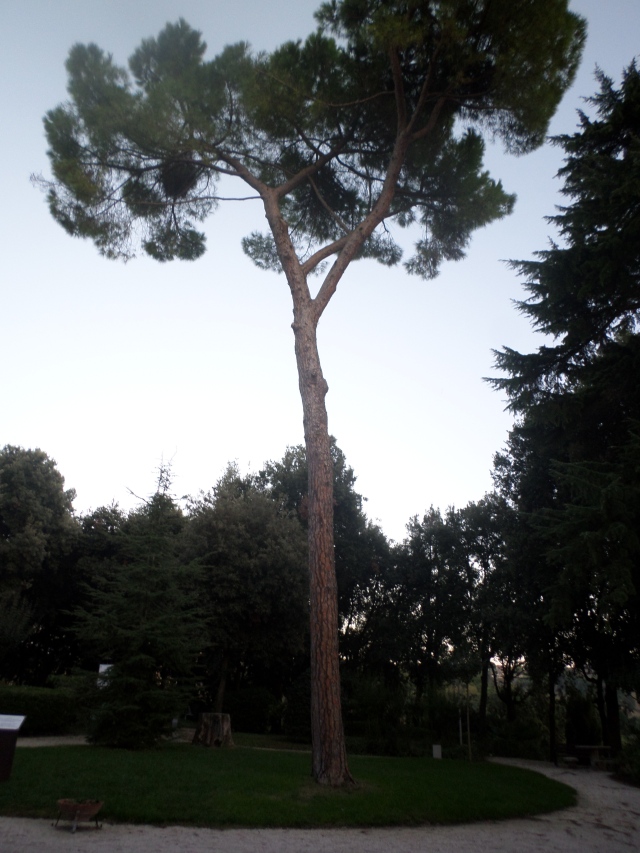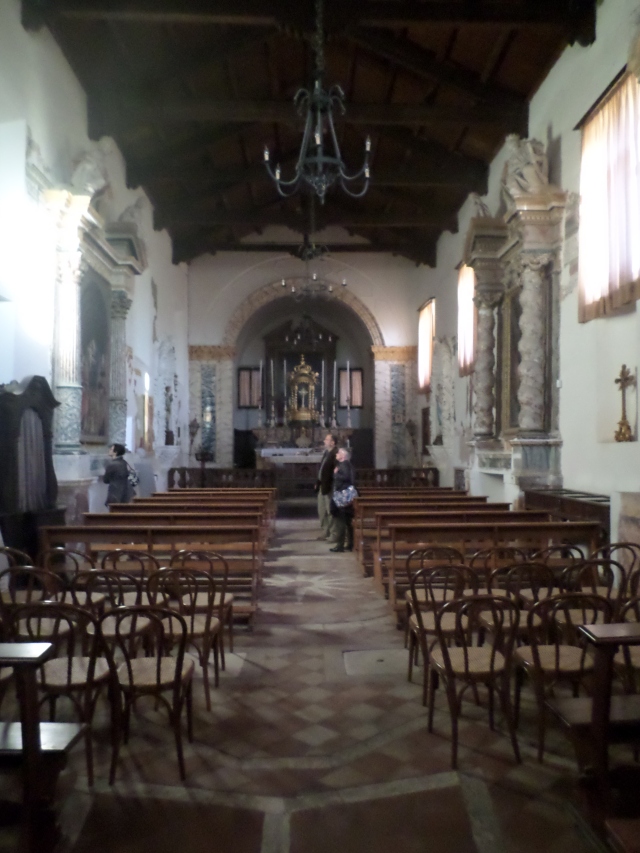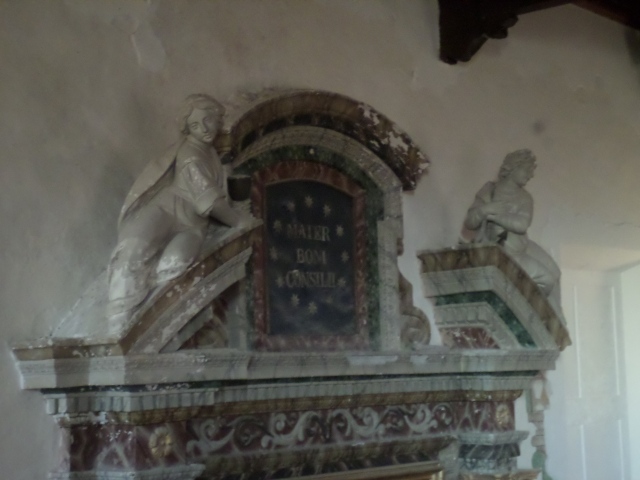We were inspired to visit this area by an article in the Daily Torygraph (alias Telegraph), which I saw on Facebook, extolling the delights of Gabicce Mare and the San Bartolo nature reserve (parco naturale). About time too! Le Marche doesn’t get nearly enough coverage in the English press. San Bartolo is one of our few rugged coastlines. Mostly the land shelves down to the sea, which means good beaches, but rows of concrete box hotels lining the road, and access to the beach via a dank tunnel under the railway. But San Bartolo and the Conero, both nature reserves, are characterised by lush woodland, steep cliffs and panoramic sea views complete with rocks and headlands.
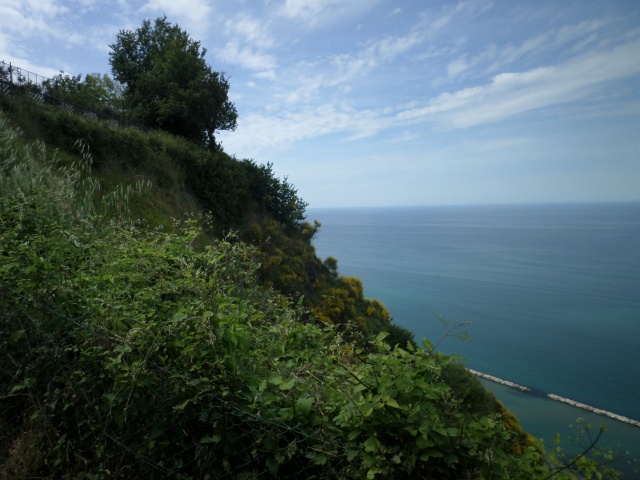
Fiorenzuola offers sun, food, woodland walks and sea … very different from our trip to Macerata, which was distinguished by rain, culture, food and urban architecture. As soon as you arrive in front of this delightful little resort’s gateway, you know what its chief claim to fame is.

Dante referred to Focara in the Inferno, the first part of his epic poem, the Commedia Divina.

Here is a basic translation of Dante’s words, courtesy of Longfellow.
“And make it known to the best two of Fano, to Messer Guido and Angiolello likewise,that if foreseeing here be not in vain, cast over from their vessel shall they be, and drowned near the Cattolica, … That traitor who sees only with one eye … will make them come to a parley with him, then will bring it about that to Focara’s wind they will not stand in need of vow nor prayer.” That is, they will be drowned before they reach Focara.
Dante seems to have thought of Le Marche (not that it existed as a demarcated region then) as a place of wind and thunder. This is what he says about Fonte Avellana:

“Tra’ due liti d’Italia surgon sassi/ e non molto distanti a la tua patria,/ tanto che’ troni assai suonan più bassi/e fanno un gibbo che si chiama Catria,/di sotto al quale e’ consecrato un ermo [Fonte Avellana], …” (Paradiso Canto XX, 106-110. The speaker is St Peter Damian.) “Between two shores of Italy rise cliffs, and not far distant from your native place, so high, the thunders far below them sound, and form a ridge that is called Catria, beneath which is consecrated a hermitage …”. (Longfellow again.)
Also just outside the walls is the war memorial
Who are the Missing (Dispersi)? Are their bones lying somewhere in Russia? And what is the story of the Caduti Civili? Surely not victims of Allied bombing in this quiet little borgo of apparently no strategic value. Were they hostages or members of the Resistance? Or were they working in Germany? And these numbers must have been a great loss to a small place.
Consequently I wasn’t sure how appropriate the sculpture below was.

This soldier seemed to emanate the very hatred and pride which the blood of the fallen was to cry out against, according to the inscription.
Within the gateway was this gentle wall-painting.

presumably a thank-offering.
Just outside the walls we had also noticed this well-placed restaurant. I bet it is impossible to find a table there in the summer season.

“La Rupe” restaurant
I said it didn’t look very exciting, but the England Fan (not a very happy bunny at the moment) said he had had a quick look inside and it stretched a long way back with a sea view. So we decided to come back there later.
We also noticed this bar, which is a popular rendez-vous for bikers, many of whom roared through the town while we were there.

On the other side of the gateway we spotted a sweet little museum. Somewhat to our surprise it was open, as the time was after 12.30. I thought the authorities deserved a reward for keeping it open , so in we went. There were no other visitors nor staff, and I couldn’t see a CCTV anywhere.
Fiorenzuola obviously prides itself on its presepi, or crib scenes, as you can tell from this somewhat battered photocopy in the museum’s vestibule.

“Fiorenzuola becomes “Crib Town”; the magic of the Nativity in 50 forms.”
The photocopy was next to this presepio, with the Holy Family, the shepherds and the three wise men to the left of the gateway. A pleasant reminder of the presepi of my childhood in Rome.

This is my favourite exhibit.

The Englishwoman is always hungry after visiting museums, and the restaurant turned out to be everyone’s idea of an Italian restaurant with a sea view.
The locals make a feature of their interesting plant-pots. This boat-shaped one was very appropriate to its surroundings.

The food was standard seaside restaurant fare- nothing wrong with it, and the waitress warmed up from professionally polite to quite friendly, once she realised I spoke Italian. Definitely worth a try, but probably not at the weekend in the summer season.
After lunch we went for a stroll. We didn’t go all the way down to the beach, because it would have taken all afternoon to come back up. There was a shuttle bus in August 2015, so maybe there’ll be another one this year.

You can see how far down the beach was. I love la ginestra (gorse); it reminds me of my Gap Year (well, three months) in Perugia. “Kissing’s out of season when gorse is out of bloom”, as the old saying, which I learned from my mother, has it.

These pine cones stuck in the grating amused me.
We went back uphill to have a look round town. On the way up we enjoyed the scallop patterns on the cobblestones and the magnificent flowers.

We also saw a few more interesting plant pots.

The grating is attractive too.

Love the abundant effect of the terracotta leaves and fruit.
At the top of town there is a pleasant little garden below a tower. I couldn’t get a decent photo of the tower – it was too tall, but the England Fan took a few of the garden.


No bicycles
I liked this driftwood sculpture at the side of the tower, arranged deliberately I’m sure.

On the other side of the tower there was a little path which looked fit for an adventure in a children’s storybook.

Have smugglers hidden their treasure in a secret entrance to the tower?
And finally …
Several bloggers whom I admire have written about Italian loos, so I’ll take a leaf out of their book, or a page out of their site.

Please do not “steal” the lavatory paper.
Public loos in Le Marche have improved a lot since 1993. This one was scrupulously clean and actually had a seat and loo roll, though no soap – thus going two better than the one under the Comune in Corinaldo.
You reach it by going through a gate and down a steep slope – a bit difficult for the elderly or those “su di giri” (a bit tight/drunk).
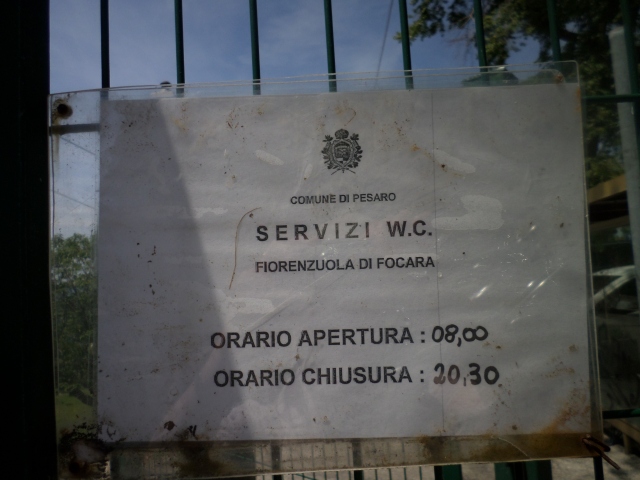
Note the opening hours.
This loo is just outside the gate, so very convenient (to coin a phrase) to use just before you go home.
From London to Longoio (and Lucca and Beyond) Part Two






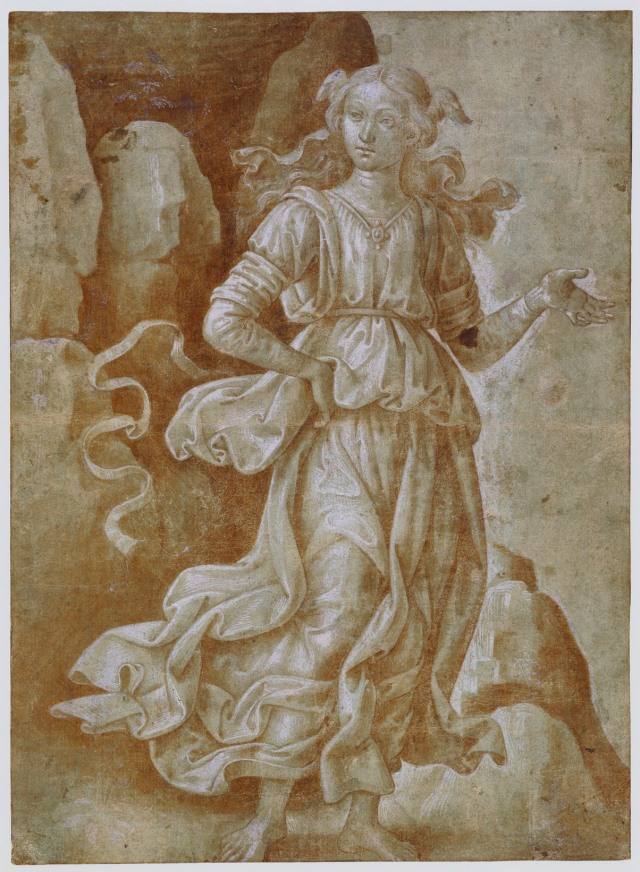









































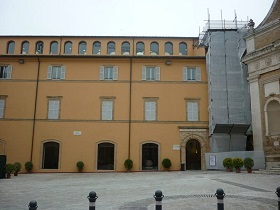 Entrance to the Mozzi-Borgetti Library, Macerata. Thanks to Cronache Maceratesi.
Entrance to the Mozzi-Borgetti Library, Macerata. Thanks to Cronache Maceratesi.  Doorway to the library. Thanks to Uma Boa Porta.
Doorway to the library. Thanks to Uma Boa Porta. 













